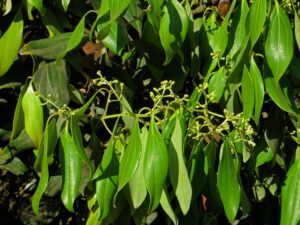- Species
- Cinnamomum gamblei
Cinnamomum gamblei

Where is this tree found?
This small tropical tree, known as ‘Kaattukaruva’ in Malayalam, is endemic to India. It is found growing in the dense, wet evergreen forests (Tropical Montane Shola Forest) in the Western Ghats across the states of Kerala, Tamil Nadu and Karnataka but is mostly confined to high altitude montane forests. This species has witnessed at least a 10% reduction in its population over the last 100 years due to land being converted into tea plantations, and the remaining population is fragmented, with restricted distribution across only 8-10 locations.
Why save this tree?
The genus Cinnamomum is highly valued for its economic and ecological importance, being the source of the spice cinnamon, several essential oils and high quality timber. C. gamblei is a wild relative of the species used commercially. This species is highly threatened due to the decline in quality and extent of habitat. Furthermore, the population of this species is estimated to consisted of 80% mature individuals – suggesting poor natural regeneration.
Within some parts of its range, the species is exposed to anthropogenic pressure due to population growth which is causing forest degradation and land conversion for agriculture and the expansion of roads. The species has been affected by the clearance of forest for tea and wattle plantations, particularly in Nilgiri.
How to save this species
It is important that extensive population surveys and searches for other extant populations are carried out to discover the true extent of the population and to develop a species recovery plan in order to raise the conservation profile of C. gamblei at the local, regional and national level. Education and outreach programmes will raise awareness of the need to protect this species and of the importance of conservation in general.
The establishment of genetically representative ex situ collections at botanic gardens across India will give this species insurance against being lost in the wild and facilitate more conservation actions. Beyond this, it’s important for the long term survival of the species in the wild that suitable sites for in situ reintroduction are identified through ecological niche modelling.
A systematic, cost-effective, and rational approach
- Population surveys
- Species recovery plan
- Identification of reintroduction sites
- Engagement of local communities
- Improvement of habitat protection
- Ex situ conservation of the species
Partners for Cinnamomum gamblei

Sponsors for Cinnamomum gamblei




